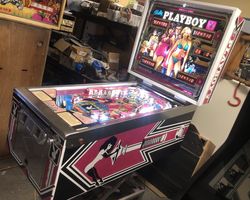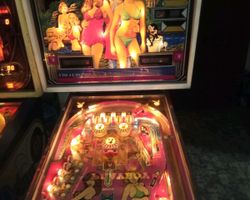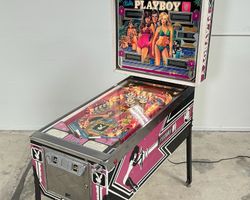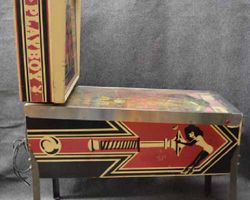Playboy
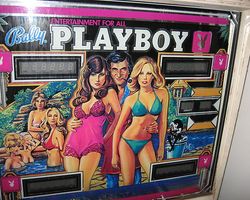
Average Prices: USD $600 to $3,000
Produced: December, 1978
Production Run: 18,250 units
Machine Type: Solid State Electronic
MPU: Bally MPU AS-2518-35
Players: 4
Design by: Jim Patla
Art by: Paul Faris
Pinball machines from the late 1970s often represent a pivotal shift in arcade entertainment, and few titles exemplify this era quite like Bally Manufacturing Corporation’s "Playboy." Released in December 1978, this solid-state electronic (SS) machine quickly became a notable entry in Bally's substantial portfolio, solidifying its place in the history of the form. With a production run of 18,250 units, "Playboy" was a commercial success, reaching a broad audience and becoming a familiar fixture in arcades and establishments of the period.
The machine's creation involved key talent within Bally. The playfield design was conceived by Jim Patla, a designer known for crafting engaging and approachable layouts. Complementing Patla's design was the distinctive artwork of Paul Faris, whose vibrant palette and characteristic style brought the licensed theme to life. Faris's artistic vision extended across the cabinet, playfield, and the iconic backglass, which notably features Hugh Hefner alongside 1976 Playmate Patti McGuire and 1977 Playmate Sondra Theodore. An intriguing detail on the backglass is the inclusion of Tom Nieman's name (or initials), then VP of Marketing for Bally Pinball, subtly placed on a champagne bottle—a signature touch he added to many games for which he secured licensing rights. The machine’s sound design also carried unique elements; its start-up tune, the dedicated Grotto tune, and the bonus score countdown melody bear a resemblance to portions of Cy Coleman's "Playboy's Theme" from the 1969 television program "Playboy After Dark." This musical connection was orchestrated by producer Vic Caesar, adding an auditory layer that was distinctive for its time.
Signature Features and Design
The visual and auditory identity of the "Playboy" pinball machine is fundamental to its appeal. Paul Faris's artwork is a defining characteristic, consistently cited for its vibrant colors and iconic imagery. The backglass, in particular, with its depiction of Hefner and the Playmates, sets the stage for the machine's theme. This artistic cohesion extends to the playfield and cabinet, creating an immersive aesthetic that was both bold and recognizable. The overall visual presentation helped "Playboy" stand out in a crowded arcade environment, making it one of the most visually striking solid-state pinball machines of its era.
Beyond the visuals, the machine’s sound package offered a unique experience for 1978. Utilizing electronic tones, chimes, and whistles, the sound design contributes significantly to the gameplay experience. The bonus countdown music, in particular, is often highlighted as a memorable auditory element, providing a distinct sonic signature that players would associate with the machine. These sounds, while perhaps rudimentary by modern standards, were sophisticated for the time and helped convey game state and progression, enhancing player engagement.
From a mechanical standpoint, two features are central to the "Playboy" experience: the prominent bank of five drop targets and the distinctive "Grotto" shot. The drop targets provide a clear and satisfying objective, their satisfying clatter upon completion signaling progress. The "Grotto" shot, located in the upper left, functions as a kickback lane, adding an element of precision and risk-reward to the gameplay. These elements are integrated seamlessly into the overall design, creating clear objectives and rewarding shots that define the machine's play.
Playfield and Mechanics
The playfield layout of the "Playboy" pinball machine, designed by Jim Patla, embodies a straightforward yet engaging philosophy, typical of solid-state machines from the late 1970s. At its core, the layout features two main flippers at the bottom, providing the primary means of ball control. Above these, two slingshots on either side redirect the ball, adding an element of unpredictability and rapid-fire action. The upper playfield is dominated by three pop bumpers, which propel the ball erratically, contributing to high-scoring opportunities and maintaining kinetic energy.
Major shots include a bank of five drop targets centrally located, a critical objective that rewards players for accuracy. Completing this bank lights various features and contributes significantly to scoring. Six standup targets are strategically placed around the playfield, offering additional scoring and progression opportunities. A star rollover target provides further chances for points and bonus accumulation. The "Grotto" shot, an upper left kickback lane, serves as a distinctive and exciting target, requiring a precise shot to activate and return the ball. The playfield also incorporates a right loop, allowing for fast, looping shots that can build momentum and score.
The design philosophy behind this layout prioritizes approachable fun and a clear progression of objectives. The game encourages players to methodically clear the drop targets and hit the various standups, while also presenting the more challenging and rewarding "Grotto" shot. The artwork on the playfield integrates seamlessly with the overall theme, with vibrant colors and illustrations that guide the player's eye to key targets and features. The lighting, while simpler than modern machines, effectively highlights scoring opportunities and mode activations, contributing to a cohesive aesthetic that immerses the player in the machine's world.
Gameplay Dynamics
The gameplay dynamics of "Playboy" are characterized by a focus on high scores through accessible mechanics and clear objectives. The maximum displayed point score of 999,990 per player encourages continuous play and strategic shot selection. The scoring system rewards accuracy on the various targets and successful completion of the game's core objectives.
Central to gameplay progression is the completion of the bank of five drop targets. Each target hit contributes to scoring, and clearing the entire bank is crucial for advancing game features and maximizing points. Another key objective involves hitting specific "Playmate targets," which can light extra ball opportunities or activate special awards, adding a layer of strategic choice. The "Grotto" shot, while often a high-risk endeavor due to its position, is a high-reward target that can significantly boost scores and trigger unique sound effects.
The gameplay is known for its relatively fast pace, which keeps players engaged and requires quick reflexes. While the core objectives are straightforward, the challenge lies in consistency and precision, especially given the game's tendency for quick drains if not managed carefully. Strategies often revolve around consistently clearing the drop targets, aiming for the "Grotto" when open, and skillfully using the flippers to control the ball's trajectory amidst the pop bumper chaos. The bonus countdown, accentuated by its unique musical theme, adds a moment of anticipation and reward at the end of each ball, making the accumulation of bonus points a significant part of the overall strategy.
Reception and Legacy
"Playboy" by Bally Manufacturing Corporation occupies a distinctive position in pinball history, largely due to its broad appeal and strong production numbers. Its reception within the pinball community has been largely positive, often buoyed by a significant wave of nostalgia from players who encountered it in their formative years. Many describe it as a "classic" and a defining machine of its solid-state era.
Among its most consistently praised strengths is the artwork. Paul Faris's vibrant and distinctive artistic style, particularly evident on the backglass and cabinet, is frequently highlighted as a major draw. The theme itself, a licensed property, resonated with many players, contributing to the machine's widespread acceptance. Gameplay is often cited as fun, simple, and easy to pick up, making it accessible to a wide range of players. The mix of shots, including the central bank of five drop targets and the notable "Grotto" shot, provides engaging objectives without overwhelming complexity. The game’s sound design, with its electronic chimes, whistles, and the memorable bonus countdown music, is considered a standout feature for its time, adding significant character to the play experience. Its fast-paced nature also contributes to its appeal, ensuring dynamic action. These factors collectively contribute to its status as a collectible item within the hobby.
However, "Playboy" is not without its criticisms. Some reviewers find the gameplay depth limited compared to later, more complex pinball machines, leading to observations that it can feel "dated" or "average" to those accustomed to modern rulesets. The sound effects, while unique for their time, are sometimes described as repetitive by some players. Additionally, a common observation is the machine's tendency to drain the ball quickly, which can lead to shorter ball times if not skillfully managed.
Despite these minor points, the legacy of the "Playboy" machine endures. Its status as one of the best-looking solid-state pins from its period remains, and for many, it stands as the preferred "Playboy" themed pinball machine over subsequent iterations. Its considerable production run of 18,250 units solidified its presence in arcades and homes, influencing countless players and helping to popularize licensed themes in pinball. As a testament to Bally's design prowess in the late 1970s, "Playboy" holds a significant place, embodying a period of transition and innovation in the industry.
Sponsored Links
 Ebay Listings
Ebay Listings
 Auction Results
Auction Results
| Cost | Location | Date |
|---|---|---|
| USD $4,500 |  Georgia, United States Georgia, United States |
23 November, 2025 |
| USD $4,889 |  Florida, United States Florida, United States |
16 October, 2025 |
| EUR €1,072 |  Nordrhein-Westfalen, Germany Nordrhein-Westfalen, Germany |
23 September, 2025 |
| USD $4,000 |  California, United States California, United States |
14 September, 2025 |
| USD $2,800 |  Indiana, United States Indiana, United States |
07 September, 2025 |
| USD $5,995 |  California, United States California, United States |
12 July, 2025 |
| USD $2,800 |  Florida, United States Florida, United States |
17 May, 2025 |
| USD $3,500 |  North Carolina, United States North Carolina, United States |
24 February, 2025 |
| USD $4,175 |  California, United States California, United States |
28 January, 2025 |
| USD $700 |  Florida, United States Florida, United States |
08 January, 2025 |


Private Policy · Search Website · Contact Us
As an eBay Partner, we may earn a commission from qualifying purchases made through links on this site, at no additional cost to you.
All trademarks and copyrighted materials remain property of their respective owners. All other content copyright 2007 - 2025 Pinpedia.

